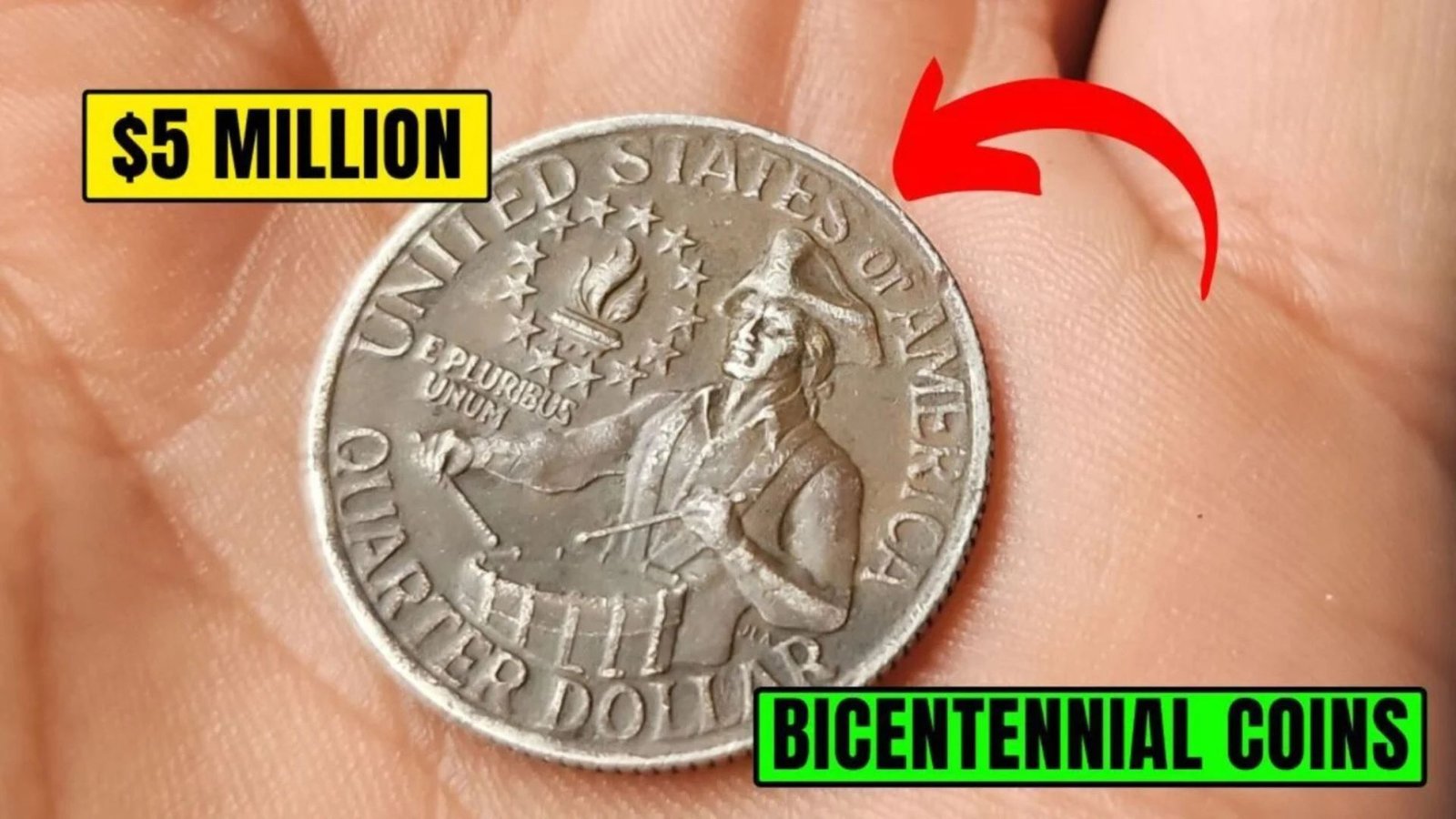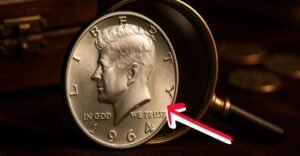Have you ever wondered if the coins jingling in your pocket could be worth a fortune? Bicentennial Quarters, minted in 1975 and 1976 to celebrate America’s 200th birthday, are common finds in everyday change. But some rare versions of these quarters are worth millions!
we’ll reveal three ultra-rare Bicentennial Quarters that could turn your spare change into a life-changing payday. Read on to learn how to spot them, why they’re so valuable, and what to do if you find one!
What Are Bicentennial Quarters?
Bicentennial Quarters were special coins released by the U.S. Mint to mark the 200th anniversary of American independence. These quarters are easy to recognize because they feature a unique design: the obverse (front) shows the usual portrait of George Washington, while the reverse (back) displays a colonial drummer and a torch surrounded by 13 stars, symbolizing the original 13 colonies. Most of these coins are worth only 25 cents, but a few rare varieties can fetch millions at auction due to minting errors or unique features.
Why Are Some Bicentennial Quarters So Valuable?
Certain Bicentennial Quarters are worth a fortune because of rare errors or special characteristics that make them stand out. These include mistakes made during the minting process, unique metal compositions, or limited production runs. Collectors are willing to pay top dollar for these coins, especially if they’re in excellent condition. Below, we’ll dive into the three rarest Bicentennial Quarters that could be hiding in your change.
The 3 Rarest Bicentennial Quarters Worth Millions
Here are the three ultra-rare Bicentennial Quarters that collectors dream of finding. Check your change carefully—you might be holding a treasure!
1. 1975-S Proof Bicentennial Quarter (No Mint Mark)
The 1975-S Proof Bicentennial Quarter is a special coin struck at the San Francisco Mint for collectors. These proof coins are made with extra care, giving them a shiny, mirror-like finish. However, a small number of these quarters were accidentally minted without the “S” mint mark, making them incredibly rare.
Why It’s Valuable
- Error: Missing “S” mint mark, which indicates it was made in San Francisco.
- Rarity: Only a handful are known to exist.
- Value: One sold for over $2.5 million at auction due to its rarity and pristine condition.
How to Spot It
- Look for a 1975 Bicentennial Quarter with a shiny, proof-like finish.
- Check the obverse (front) for the absence of the “S” mint mark near Washington’s head.
- The coin should have sharp details and a polished appearance.
2. 1976-D Bicentennial Quarter Struck on a Silver Planchet
Most Bicentennial Quarters were made from a copper-nickel blend, but a few were accidentally struck on 40% silver planchets (blanks) meant for special collector coins. These errors happened at the Denver Mint, and the resulting coins are highly sought after.
Why It’s Valuable
- Error: Struck on a silver planchet instead of copper-nickel.
- Rarity: Very few were made, as this was a minting mistake.
- Value: These coins have sold for up to $3 million at auctions.
How to Spot It
- Check for a 1976 Bicentennial Quarter with a “D” mint mark (for Denver).
- The coin may look slightly shinier or have a silver-like color compared to regular quarters.
- Weigh the coin: Silver planchet quarters weigh about 5.75 grams, while copper-nickel ones weigh 5.67 grams.
3. 1976 Bicentennial Quarter Double Die Obverse
A double die error occurs when the coin’s design is stamped twice, slightly offset, creating a doubled appearance in the lettering or image. The 1976 Bicentennial Quarter with a double die obverse is one of the most coveted error coins.
Why It’s Valuable
- Error: The doubling effect on the obverse, especially in the lettering or Washington’s portrait.
- Rarity: Only a small number of these coins were produced.
- Value: High-grade examples have fetched over $1.5 million at auction.
How to Spot It
- Look for a 1976 Bicentennial Quarter with noticeable doubling in the words “LIBERTY” or “IN GOD WE TRUST” on the front.
- Use a magnifying glass to check for doubled lines or blurred details in the design.
- The doubling is most visible under close inspection.
How to Check Your Bicentennial Quarters
Think you might have one of these rare coins? Here’s a step-by-step guide to inspecting your Bicentennial Quarters:
- Check the Date: Look for quarters dated 1975 or 1976.
- Examine the Mint Mark: Find the mint mark (if any) near Washington’s head. “S” means San Francisco, “D” means Denver, and no mark means Philadelphia.
- Look for Errors: Use a magnifying glass to check for missing mint marks, doubling, or unusual metal color.
- Weigh the Coin: A precise scale can help identify silver planchet errors.
- Condition Matters: Coins in great condition (no scratches or wear) are worth more.
Key Features of Rare Bicentennial Quarters
| Coin Type | Error/Feature | Mint Mark | Estimated Value | How to Identify |
|---|---|---|---|---|
| 1975-S Proof (No Mint Mark) | Missing “S” mint mark | None | Up to $2.5M | Shiny, proof-like finish, no “S” near Washington |
| 1976-D Silver Planchet | Struck on 40% silver | D | Up to $3M | Silver color, weighs ~5.75 grams |
| 1976 Double Die Obverse | Doubling on front design | Any | Up to $1.5M | Doubled “LIBERTY” or “IN GOD WE TRUST” |
What to Do If You Find a Rare Bicentennial Quarter
If you think you’ve found one of these rare Bicentennial Quarters, here’s what to do next:
- Don’t Clean the Coin: Cleaning can damage the coin and lower its value.
- Store It Safely: Keep it in a protective holder to avoid scratches.
- Get It Appraised: Contact a professional coin grader, like PCGS or NGC, to verify its authenticity and condition.
- Consider Selling: Work with a reputable auction house or coin dealer to sell your coin for the best price.
Where to Sell Your Coin
- Auction Houses: Heritage Auctions or Stack’s Bowers specialize in rare coins.
- Coin Dealers: Local or online dealers can offer appraisals and purchase offers.
- Online Marketplaces: eBay or specialized coin forums, but be cautious of scams.
Why Collectors Love Bicentennial Quarters
Bicentennial Quarters are more than just coins—they’re pieces of American history. The unique design, limited minting errors, and the excitement of finding a rare coin make them a favorite among collectors. Plus, the potential to turn pocket change into millions adds a thrilling treasure-hunt vibe!
Tips for Coin Collectors
- Start Small: Begin by checking your change or buying rolls of quarters from banks.
- Learn the Lingo: Understand terms like “proof,” “mint mark,” and “double die.”
- Join a Community: Connect with other collectors through forums or local coin clubs.
- Stay Updated: Follow auction results and coin news to spot valuable finds.
Final Thoughts: Your Change Could Be Worth Millions!
Next time you’re digging through your pocket change, take a closer look at those Bicentennial Quarters. A missing mint mark, a silver shine, or a doubled design could mean you’re holding a coin worth millions. By knowing what to look for and how to check your coins, you could uncover a hidden treasure. So, grab a magnifying glass, check your change, and who knows—you might just become a millionaire!




